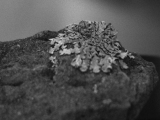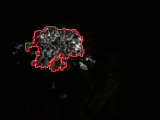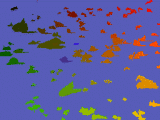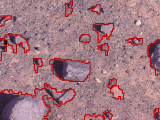| Carnegie Mellon | Robotics Institute | Field Robotics Center | NASA | ASTEP |

Robotics
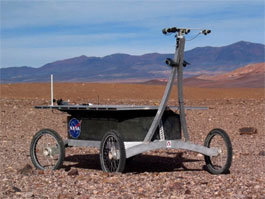 |
Rover Specifications:
|
Rover Science Payload: - Environmental Sensors - Mars Microbeam Raman Spectrometer (MMRS) - Bio UV Flourescence Imager (BUF) - Panoramic Imager - Sampling Drill - Regolith Sample Handling Unit - Visible and Near-Infared Spectrometer For more details click here to visit Astrobiology. |
Zoë is designed to be a highly capable robotic astrobiologist. Equipped with specialized sensors, Zoë can autonomously roam the Atacama desert in search of life. Zoë was given its name because it is the Greek word for "life."
Zoë:
What does Zoë look like?Zoë is about three meters long and two meters wide with a panel of silicon solar cells of 3.5 square meters. All of Zoë's computers, electronics and batteries are enclosed in a single body mounted between the axles. The robot weighs around 200 kilograms.
How does Zoë drive and steer?
Zoë is driven by four motors, one for each wheel. It has a passive (unactuated)
joint at the front axle that can roll and yaw relative to the back end—similar
to a wagon. It steers by driving the wheels at different speeds but instead
of skidding like a bulldozer, the passive joint turns and the robot smoothly
follows arcs. The advantage of this design is that the number of actuators is minimized (there
are only four motors) but energy is not wasted skidding the wheels when
turning.
What sensors does Zoë use?
Zoë uses a pair of cameras to image the terrain in front of it. By using stereo vision
the robot can dedect obstacles and safe areas for driving. There is also a downward looking camera
that is used for determing the rovers speed using optical flow. Zoë also has an IMU that can detect acclerations and
rotations made by the robot. The downward looking camera and IMU data are merged in a filter on the computer to determine the
rovers position since we can not rely on GPS (no GPS on Mars).
There are also speed and current sensors for each motor and system level voltage and current sensors.
These sensors are used for planning and determing system power usage. There are also temperature
sensors throughout the rover so the rover can monitor itself for overheating.
How is Zoë powered?
All of Zoë’s energy comes from the sun. Its solar cells supply its
power bus, which runs computers and sensors, drives the wheels and charges
batteries. The output of the solar panels depends on the solar flux which is
a function of the orientation of the panel and atmospheric conditions. The
overall power tracking system is 11% efficient so if 600 W/m2 of solar energy
(a typical value) falls on the 3.5m2 panels then Zoë will have about 200W
to use. Any excess power is put into a bank of lead-acid batteries so that
Zoë has capacity to climb a steep slope, drive over an obstacle, or
take a shortcut through a shadow or away from the sun when necessary. It’s
battery capacity is 32Ahr at 24V.
How does Zoë avoid obstacles like rocks and slopes?
To travel through terrain Zoë uses a pair of cameras, like eyes, and computer
algorithms to see, measure and model obstacles in its immediate surroundings.
It then evaluates multiple possible paths that avoid the obstacles, selecting
a path that heads toward its goal while collecting sufficient solar energy
to proceed.
Science on the Fly:
|
Currently, rovers can travel tens of meters per sol, but the next generation of rovers is predicted to be able to traverse ten or more times as far. This capability presents a situation in which the rover will be able to travel to places about which it has no information and which it was not able to see at the beginning of the sol. This presents us with not only an exciting opportunity but also several challenges. This situation will require the rover to use methods for performing effective science when the rover has left the area that was initially visible and is out of contact with scientists. The "Science on the Fly" software consists of two principal parts, the science observer and the science planner. The science observer acts as the rover's eyes and ears. The science observer interprets sensor data to find possible targets of scientific value. The other part, the science planner, takes the observations made by the science observer and plans experiments that would be of maximum scientific value. The Science Observer serves two major roles: identifying targets of interest and categorizing them into useful groups. For example, the most prominent targets for geological study are rocks. When the science observer examines an image, it looks for rocks using a "machine learning" algorithm that has been trained ahead of time to recognize rock-like features. Then, it autonomously categorizes those rocks into groups based on data it has seen before. In this manner, the Science Observer can recognize novel rocks as well as perform automatic geological analyses. Besides rocks, targets of scientific interest could include lichens or patches of soil. The Science Planner enables the rover to react to new science opportunities as it moves into unexplored areas. The Science Planner accepts priorities from the science team, such as "carbonate rocks are important to sample." Then, when the Science Observer detects a high-priority, interesting feature, the Science Planner tries to make a plan for getting more useful information about the feature. For instance, it might move closer and examine the feature with its fluorescence sensor to look for signs of life. It is not always easy to generate this kind of plan because examining every interesting feature would take far more time and energy than the rover has available. |
|
